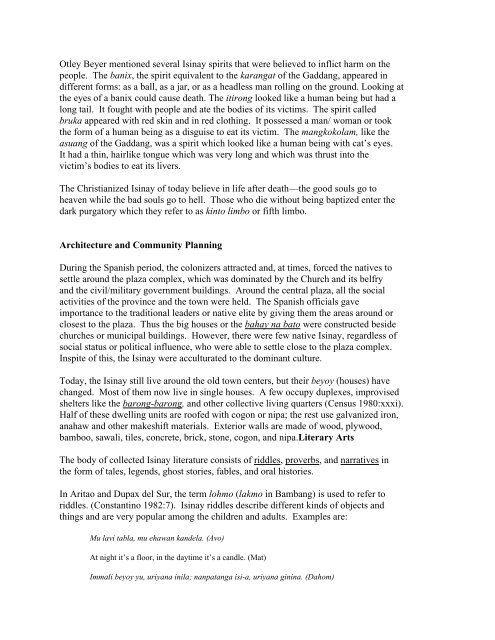“Isinay” is derived from the prefix “i” meaning “native, resident ...
“Isinay” is derived from the prefix “i” meaning “native, resident ...
“Isinay” is derived from the prefix “i” meaning “native, resident ...
Create successful ePaper yourself
Turn your PDF publications into a flip-book with our unique Google optimized e-Paper software.
Otley Beyer mentioned several Isinay spirits that were believed to inflict harm on <strong>the</strong><br />
people. The banix, <strong>the</strong> spirit equivalent to <strong>the</strong> karangat of <strong>the</strong> Gaddang, appeared in<br />
different forms: as a ball, as a jar, or as a headless man rolling on <strong>the</strong> ground. Looking at<br />
<strong>the</strong> eyes of a banix could cause death. The itirong looked like a human being but had a<br />
long tail. It fought with people and ate <strong>the</strong> bodies of its victims. The spirit called<br />
bruka appeared with red skin and in red clothing. It possessed a man/ woman or took<br />
<strong>the</strong> form of a human being as a d<strong>is</strong>gu<strong>is</strong>e to eat its victim. The mangkokolam, like <strong>the</strong><br />
asuang of <strong>the</strong> Gaddang, was a spirit which looked like a human being with cat’s eyes.<br />
It had a thin, hairlike tongue which was very long and which was thrust into <strong>the</strong><br />
victim’s bodies to eat its livers.<br />
The Chr<strong>is</strong>tianized Isinay of today believe in life after death—<strong>the</strong> good souls go to<br />
heaven while <strong>the</strong> bad souls go to hell. Those who die without being baptized enter <strong>the</strong><br />
dark purgatory which <strong>the</strong>y refer to as kinto limbo or fifth limbo.<br />
Architecture and Community Planning<br />
During <strong>the</strong> Span<strong>is</strong>h period, <strong>the</strong> colonizers attracted and, at times, forced <strong>the</strong> natives to<br />
settle around <strong>the</strong> plaza complex, which was dominated by <strong>the</strong> Church and its belfry<br />
and <strong>the</strong> civil/military government buildings. Around <strong>the</strong> central plaza, all <strong>the</strong> social<br />
activities of <strong>the</strong> province and <strong>the</strong> town were held. The Span<strong>is</strong>h officials gave<br />
importance to <strong>the</strong> traditional leaders or native elite by giving <strong>the</strong>m <strong>the</strong> areas around or<br />
closest to <strong>the</strong> plaza. Thus <strong>the</strong> big houses or <strong>the</strong> bahay na bato were constructed beside<br />
churches or municipal buildings. However, <strong>the</strong>re were few native Isinay, regardless of<br />
social status or political influence, who were able to settle close to <strong>the</strong> plaza complex.<br />
Inspite of th<strong>is</strong>, <strong>the</strong> Isinay were acculturated to <strong>the</strong> dominant culture.<br />
Today, <strong>the</strong> Isinay still live around <strong>the</strong> old town centers, but <strong>the</strong>ir beyoy (houses) have<br />
changed. Most of <strong>the</strong>m now live in single houses. A few occupy duplexes, improv<strong>is</strong>ed<br />
shelters like <strong>the</strong> barong-barong, and o<strong>the</strong>r collective living quarters (Census 1980:xxxi).<br />
Half of <strong>the</strong>se dwelling units are roofed with cogon or nipa; <strong>the</strong> rest use galvanized iron,<br />
anahaw and o<strong>the</strong>r makeshift materials. Exterior walls are made of wood, plywood,<br />
bamboo, sawali, tiles, concrete, brick, stone, cogon, and nipa.Literary Arts<br />
The body of collected Isinay literature cons<strong>is</strong>ts of riddles, proverbs, and narratives in<br />
<strong>the</strong> form of tales, legends, ghost stories, fables, and oral h<strong>is</strong>tories.<br />
In Aritao and Dupax del Sur, <strong>the</strong> term lohmo (lakmo in Bambang) <strong>is</strong> used to refer to<br />
riddles. (Constantino 1982:7). Isinay riddles describe different kinds of objects and<br />
things and are very popular among <strong>the</strong> children and adults. Examples are:<br />
Mu lavi tabla, mu ehawan kandela. (Avo)<br />
At night it’s a floor, in <strong>the</strong> daytime it’s a candle. (Mat)<br />
Immali beyoy yu, uriyana inila; nanpatanga <strong>is</strong>i-a, uriyana ginina. (Dahom)
















